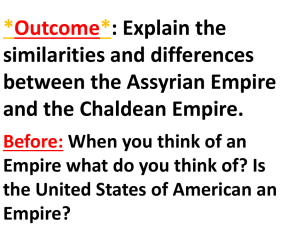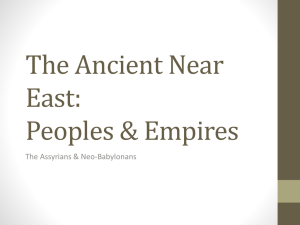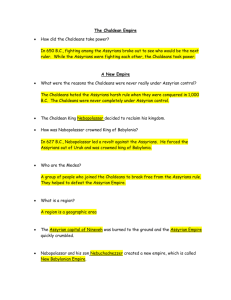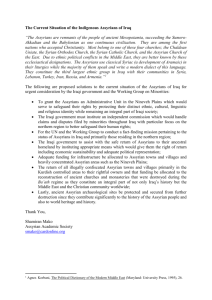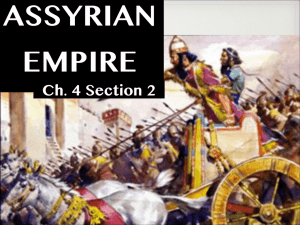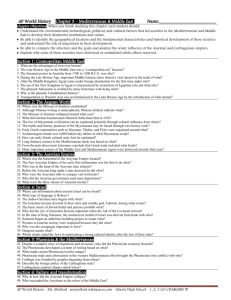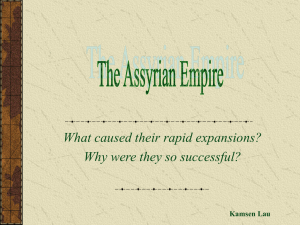Assyria - Amherst Education Center
advertisement
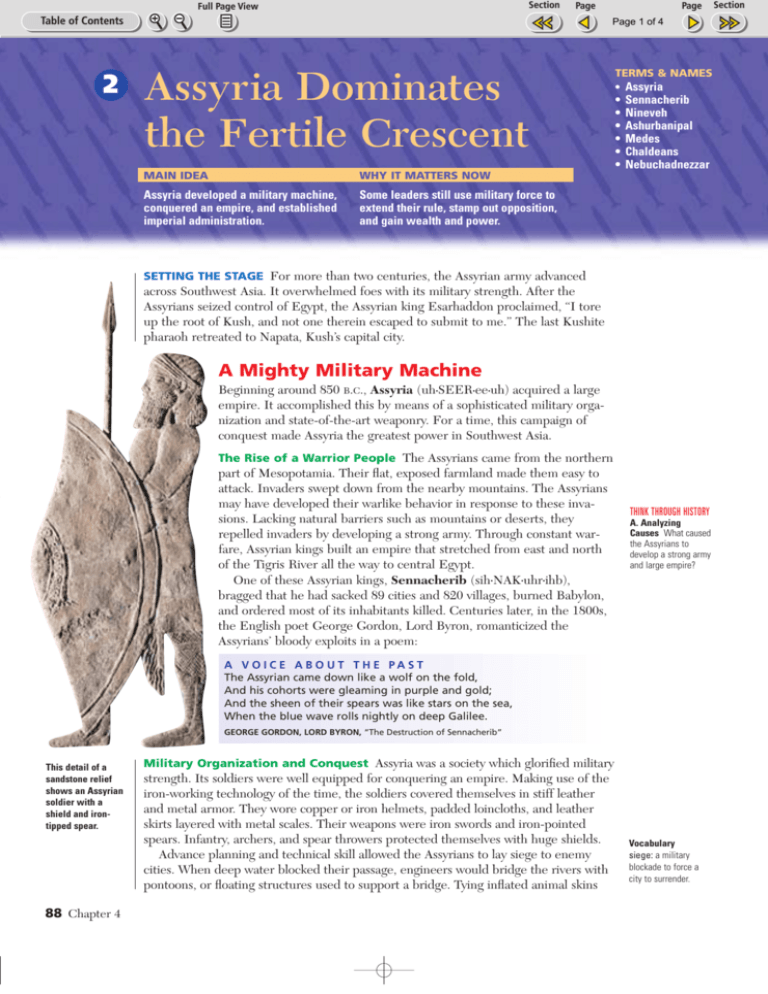
088-91-0104s2 10/11/02 2 3:33 PM Page 88 Page 1 of 4 Assyria Dominates the Fertile Crescent TERMS & NAMES • Assyria • • • • • • MAIN IDEA WHY IT MATTERS NOW Assyria developed a military machine, conquered an empire, and established imperial administration. Some leaders still use military force to extend their rule, stamp out opposition, and gain wealth and power. Sennacherib Nineveh Ashurbanipal Medes Chaldeans Nebuchadnezzar SETTING THE STAGE For more than two centuries, the Assyrian army advanced across Southwest Asia. It overwhelmed foes with its military strength. After the Assyrians seized control of Egypt, the Assyrian king Esarhaddon proclaimed, “I tore up the root of Kush, and not one therein escaped to submit to me.” The last Kushite pharaoh retreated to Napata, Kush’s capital city. A Mighty Military Machine Beginning around 850 B.C., Assyria (uh SEER ee uh) acquired a large empire. It accomplished this by means of a sophisticated military organization and state-of-the-art weaponry. For a time, this campaign of conquest made Assyria the greatest power in Southwest Asia. • • • The Rise of a Warrior People The Assyrians came from the northern part of Mesopotamia. Their flat, exposed farmland made them easy to attack. Invaders swept down from the nearby mountains. The Assyrians may have developed their warlike behavior in response to these invasions. Lacking natural barriers such as mountains or deserts, they repelled invaders by developing a strong army. Through constant warfare, Assyrian kings built an empire that stretched from east and north of the Tigris River all the way to central Egypt. One of these Assyrian kings, Sennacherib (sih NAK uhr ihb), bragged that he had sacked 89 cities and 820 villages, burned Babylon, and ordered most of its inhabitants killed. Centuries later, in the 1800s, the English poet George Gordon, Lord Byron, romanticized the Assyrians’ bloody exploits in a poem: • • • THINK THROUGH HISTORY A. Analyzing Causes What caused the Assyrians to develop a strong army and large empire? A. Possible Answer No natural barriers to invasion; needed strong army to repel invaders; constant warfare produced large empire. A V O I C E A B O U T T H E PA S T The Assyrian came down like a wolf on the fold, And his cohorts were gleaming in purple and gold; And the sheen of their spears was like stars on the sea, When the blue wave rolls nightly on deep Galilee. GEORGE GORDON, LORD BYRON, “The Destruction of Sennacherib” This detail of a sandstone relief shows an Assyrian soldier with a shield and irontipped spear. 88 Chapter 4 Military Organization and Conquest Assyria was a society which glorified military strength. Its soldiers were well equipped for conquering an empire. Making use of the iron-working technology of the time, the soldiers covered themselves in stiff leather and metal armor. They wore copper or iron helmets, padded loincloths, and leather skirts layered with metal scales. Their weapons were iron swords and iron-pointed spears. Infantry, archers, and spear throwers protected themselves with huge shields. Advance planning and technical skill allowed the Assyrians to lay siege to enemy cities. When deep water blocked their passage, engineers would bridge the rivers with pontoons, or floating structures used to support a bridge. Tying inflated animal skins Vocabulary siege: a military blockade to force a city to surrender. 088-91-0104s2 10/11/02 3:33 PM Page 89 Page 2 of 4 Assyrian Military Power Assyrian warriors were ferocious in combat. In this relief—sculpture that has figures standing out from a flat background—they are shown launching an assault on a fortified city. The Assyrian war machine included a variety of weapons and methods of attack. 1 Ladders While Assyrian archers launched waves of arrows against their opponents defending the city walls, Assyrian troops threw their ladders up against the walls and began their climb into the enemy’s stronghold. 2 1 2 Weapons 3 Troops were armed with the best weapons of the time, iron-tipped spears, as well as iron daggers and swords. They were also protected with armor and large shields. 3 Tactics The Assyrians were savage in their treatment of defeated opponents. Those who weren’t slaughtered in the initial attack were often impaled or beheaded, while women and children were sometimes murdered or sold into slavery. 2 4 4 Tunnels The Assyrian army used sappers—soldiers who dug tunnels to sap, or undermine, the foundations of the enemy’s walls so that they would fall. Background Assyrian archers served as a kind of early form of artillery, clearing the enemy’s walls of defenders so Assyrian troops could storm them. together, they connected these pontoons to the shore with beams. Then they erected a raised dirt roadway at both ends. An armed guard protected the soldiers who installed a support structure of stones, brush, and clay. Before attacking, the Assyrians dug beneath the city’s walls to weaken them. Then, with disciplined organization, foot soldiers marched shoulder to shoulder. A trained cavalry, or troops riding horses, galloped into battle, following their generals, who rode in chariots. With courage and coordination, foot soldiers approached to within an arrow’s shot of the city walls. At a signal from their commander, they stopped, strung their bows, and released a shower of arrows. Wave upon wave of arrows hissed over the walls of the besieged city. Meanwhile, another group of troops hammered the city’s gates with massive, iron-tipped battering rams. When at last the city gates splintered, the Assyrians showed no mercy. They killed or enslaved their victims. Because soldiers received a bounty for severed heads, many of the defeated were beheaded. One Assyrian king bragged of burning 3,000 captives to death. Another told how “all the chiefs who had revolted I flayed, with their skins I covered the pillar, some in the midst I walled up, others on stakes I impaled, still others I arranged around the pillar on stakes.” To prevent later rebellions, the Assyrians forced groups of captives to leave their homelands. They were forced to settle far away as exiles in the empire’s distant provinces and dependent states. An Expanding Empire Between 850 and 650 B.C., the kings of Assyria defeated Syria, Palestine, and Babylonia. Reaching beyond the Fertile Crescent, Assyrian rule extended into Egypt and Anatolia. With the conquest of Egypt, the Assyrian Empire had established itself in North Africa. First Age of Empires 89 088-91-0104s2 10/11/02 3:33 PM Page 90 Page 3 of 4 Assyrian Empire, 650 B.C. Assyrian Rule At its peak around 650 B.C., spi an Sea AN AT O L I A TAUR M US . Nineveh M edes Ashur SYRIA E hra OS . P er sian s M TS . C haldeans Pe an Red rsi DESERT SAHARA A SIA BABYLONIA ARABIAN EGYPT R Babylon Jerusalem Memphis tes GR Sidon Tyre . sR Mediterranean PHOENICIA Sea PALESTINE ZA up Tigri CYPRUS TS this empire included almost all of the old centers of civilization and power in Southwest Asia. With great efficiency, the Assyrians organized their conquered territories into an empire. Assyrian officials governed lands closest to Assyria as provinces and made them dependent territories. Assyrian kings influenced these dependent regions by choosing their rulers. Or, they supported kings who aligned themselves with Assyria. Assyrian armies protected the dependent territories from invasion by other enemies. In addition, the military campaigns added new territory to the empire. This brought in taxes and tribute to the Assyrian treasury. These became an instrument of control. If a conquered people refused to pay, the Assyrians destroyed their cities and sent the people into exile. By these means the Assyrians developed an effective method of governing an extended empire. Ca 40°N 40°E Black Sea Gu Thebes lf Sea 1,000 Miles Ri ver 0 N il e 0 2,000 Kilometers G E O G R A P H Y S K I L L B U I L D E R : Interpreting Maps 1. Location What is the approximate distance between Nineveh and Thebes? 2. Location What is the southernmost part of the Assyrian Empire and to what other empire did it previously belong? • • • The Empire Crumbles Ashurbanipal proved to be one of the last of the mighty Assyrian kings. Assyrian power had spread itself too thin. Also, the cruelty displayed by the Assyrians had earned them many enemies. Shortly after Ashurbanipal’s death, Nineveh fell. Decline and Fall Just as Assyrians had destroyed so many cities, Assyria’s enemies demolished Nineveh. In 612 B.C., a combined army of Medes (meedz), Chaldeans (kal DEE uhnz), and others rammed open the city’s gates. Their armies burned and leveled Nineveh. The fire glazed the tablets in the library, which preserved them for archaeologists to study centuries later. So thoroughly did the armies destroy Nineveh that two centuries later only mounds remained. 90 Chapter 4 • B. Recognizing Causes What methods enabled the Assyrians to rule their empire effectively? • • • THINK THROUGH HISTORY Assyrian Culture Some of Assyria’s most fearsome warriors earned a reputation as great builders. For example, the same King Sennacherib who had burned Babylon also established Assyria’s capital at Nineveh (NIHN uh vuh) along the Tigris River. This great walled city, about three miles long and a mile wide, was famous as the largest city of its day. In the ruins of Nineveh and other Assyrian cities, archaeologists found finely carved sculptures. Two artistic subjects particularly fascinated the Assyrians: brutal military campaigns and the lion hunt. In addition to the treasures of empire, Nineveh also held one of the ancient world’s largest libraries. King Ashurbanipal (ah shur BAH nuh pahl) prided himself on his ability to read in several languages: “The beautiful writings in Sumerian that are obscure, in Akkadian that are difficult to bear in mind, it was my joy to repeat.” This kingly reader collected more than 25,000 clay tablets from throughout the Fertile Crescent. Some were dictionaries containing the same words in several languages. When archaeologists uncovered the library’s remains in the mid-1800s, the dictionary tablets enabled scholars to better understand Mesopotamian writing. • B. Possible Answer Efficient organization; military power; taxes; tribute; system of provinces made dependent territories. THINK THROUGH HISTORY C. Making Inferences Why might the Assyrian warrior kings have had such a great interest in writing and reading? C. Possible Answer They may have envisioned the writing of their history as a way to impress future generations with their military achievements. 088-91-0104s2 10/11/02 3:33 PM Page 91 Page 4 of 4 Many people in the region rejoiced at Nineveh’s destruction. The Hebrew prophet Nahum (NAY huhm) gave voice to the feelings of many: • THE BIBLE And it shall come to pass, that all they that look upon thee shall flee from thee, and say, Nineveh is laid waste: who will bemoan her? Whence shall I seek comforters for thee? . . . Thy shepherds slumber, O king of Assyria: thy nobles shall dwell in the dust: thy people is scattered upon the mountains, and no man gathereth them. THINK THROUGH HISTORY D. Clarifying What was Nahum’s opinion about the collapse of the Assyrian Empire? D. Possible Answer This cruel empire would have no mourners; it would be dispersed and no one would care. NAHUM 3:7,18 Rebirth of Babylon Under the Chaldeans After defeating the Assyrians, the Chaldeans made Babylon their capital. Around 600 B.C., Babylon became the center of a new empire, more than 1,000 years after Hammurabi had ruled there. A Chaldean king named Nebuchadnezzar (nehb uh kuhd NEHZ uhr) restored Babylon. The most impressive part of his palace may have been the famous hanging gardens. Greek scholars later listed them as one of the Seven Wonders of the World. According to legend, one of Nebuchadnezzar’s wives missed the flowering shrubs of her mountain homeland. To please her, the king had fragrant trees and mountain shrubs planted on terraces. They rose 75 feet above Babylon’s flat, dry plain. Slaves watered the plants from hidden pumps. Indeed, the entire city was a wonder. Its walls were so thick that, according to one report, a four-horse chariot could wheel around on top of them. To ensure that the world knew who ruled Babylon, even the bricks were inscribed, “I am Nebuchadnezzar, King of Babylon.” The highest building in Babylon was a great, seven-tiered ziggurat more than 300 feet high. It was visible for miles. At night, priests observed the stars from the top of this tower and others in the city. They kept detailed records of how the stars and planets seemed to change position in the night sky. The Chaldeans’ observations formed the basis for both astronomy and astrology. Nebuchadnezzar’s empire fell shortly after his death. The Persians who next came to power adopted many Assyrian military, political, and artistic inventions. The Persians would use the organization the Assyrians had developed to stabilize the region. • • • • Lions made of glazed bricks decorated walls along the broad road that passed the Ishtar Gate of Nebuchadnezzar in Babylon. Section 2 Assessment 1. TERMS & NAMES 2. TAKING NOTES Identify • Assyria • Sennacherib • Nineveh • Ashurbanipal • Medes • Chaldeans • Nebuchadnezzar Create a diagram showing the causes of the rise and of the decline of Assyrian power. Assyrian Military Power Causes of Increasing Power 1. 2. 3. Causes of Declining Power 1. 2. 3. 3. FORMING AND SUPPORTING OPINIONS The Assyrians relied almost exclusively on military power in building, maintaining, and ruling their empire. Explain whether you think this was a good strategy. 4. THEME ACTIVITY Science and Technology Work with a partner to draw a mural highlighting how developments in technology influenced the rise and decline of the Assyrian Empire. THINK ABOUT • the causes of Assyrian military power • the stability of the empire • the methods that empires use to become stronger First Age of Empires 91

